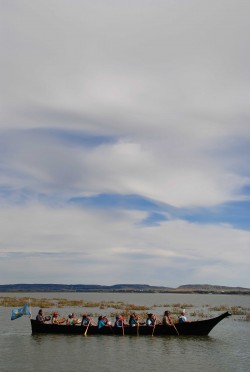News | September 14th, 2016
__250-wide.jpg)
By C. S. Hagen
cshagen@gmail.com
Big Camp, ND – Centuries before the discovery of oil, a hungry bear lumbered into a forest and began gorging on all the huckleberries it could find, according to ancient Native American legends. The forest animals took notice, and held council, for without huckleberries a vital part of the forest would surely be lost.
After reaching a decision the forest animals timidly approached the bear and warned it to stop before the damage was irreparable; a price had to be paid. The bear needed to give something back for the carnage it created.
“But all I have is my fur and my claws,” the bear said.
“You must give up your eyesight,” the animals said.
The bear agreed, and to this day the tender, versatile fruit has an eye on every berry, and bears have never regained the eyesight they once had.
Told late at night in Big Camp, short hikes from the Camp of the Sacred Stone and Red Warriors Camp outside of Cannon Ball, the legend is the difference between life and death to the largest gathering of Native American tribes in 140 years. Not since the Battle of the Greasy Grass or Custer’s Last Stand, have the Great Sioux Nation’s Seven Council Fires, or the Oceti Sakowin, been united.
In addition, more than 200 tribes, 100 social groups and associations, at times exceeding 5,000 people of all nationalities, are not only protecting water, now they’re protecting land. Smaller camps have been established along rural roads; scouts are tirelessly on the lookout for Dakota Access activity.
On September 3, activists say Dakota Access Pipeline orchestrated a “sneak attack” that desecrated two miles of Native American burial grounds. Allegedly, an Ohio-based dog breeding and training company, known by netizens as Frost Kennels, attempted to ward off the protesters – men, women, and children – with mace and trained attack dogs. Mercenaries, activists called them.
Altercations ensued, Morton County Sheriff's Department reported, but activists say only after security personnel allegedly pushed attack dogs into the crowds. At least six activists, including a young woman bit on the breast and one child who broke out in a rash after being hit in the face with mace, sought medical help, activists said.
Activists forced security personnel to retreat after the attacks ensued. Frost Kennels admitted their personnel were at the Dakota Access Pipeline area on Facebook.
“They provoked everything that happened,” Standing Rock Sioux Chairman Dave Archambault II said. “We are not violent, but when you have companies provoking, it is hard to keep going. It’s time to stop infringing on indigenous rights.”
__250-wide.jpg)
Law enforcement watched from a nearby hill, activists said.
“They didn’t try to deescalate either side,” Dale “Happi” Americanhorse Jr. said. “What happened on Saturday, it was hateful.”
The day after the altercation, Standing Rock Sioux tribe asked the U.S. District Court for the District of Columbia to grant a temporary restraining order against Dakota Access, which was partially granted by U.S. Judge James Boasberg. The U.S. Army Corps of Engineers, on whose land the altercation took place, did not oppose the issuance of the restraining order.
“This is a peace and prayer camp, we’re not here to start World War III,” Greg Cournoyer Jr., a councilman for the Yankton Sioux tribe said. The Yankton Sioux Tribe filed a lawsuit in federal court on September 8, according to Native News. With Cournoyer stood a fifth generation descendant of Colonel George Armstrong Custer, Whitney Custer, who has Cheyenne blood. From Kansas, she could not stay at the camp for long, as sixth generation Custers waited for her at home.
Although 140 years ago the Sioux soundly defeated and killed her cavalier ancestor, Custer felt nothing but acceptance from the Native Americans at Big Camp.
“I have been welcomed with happiness,” Custer said. “They’ve treated me like family, I feel very welcome.”
As soon as she stopped speaking, a mosquito-like buzz filled the air. Everyone looked up and pointed toward a circling drone. Sightings of helicopters and airplanes are commonplace, but activists now face the U.S. military. In preparation for the U.S. District Court for the District of Columbia decision on an injunction filed by Standing Rock Sioux Tribe to stop work along the pipeline, Governor Jack Dalrymple called in the North Dakota National Guard. Judge Boasberg’s long-awaited decision on Friday favored the Dakota Access Pipeline, and the company was legally allowed to continue work.
__250-wide.jpg)
“It is now clear and obvious the fight needs to be moved from Morton County to a courtroom in Washington, D.C.,” Morton County Commissioner Cody Schulz said.
Near Cannon Ball, however, local and state law enforcement officials have had their hands full, arresting more than 60 activists since the protests began, and have issued warrants for presidential candidate Dr. Jill Stein, and her running mate, Ajamu Baraka.
On Friday, Stein posted on her Twitter account, “Why is an arrest warrant out for me and @ajamubaraka, instead of Big Oil and the state of North Dakota?”
To ease some of law enforcement’s pressures along Highway 1806, on September 8 Dalrymple called in the military to act in a limited capacity, bolstering traffic checks and assisting law enforcement. The road is now open to the public, Archambault said, but the military presence did not disturb nor dismay him.
“The National Guard is not going to come here to the camps,” Archambault said. “The governor is trying to alleviate some of the pressures on local law enforcement.”
“Our mission is, and in this situation is the right approach, is to have guardsmen in support of law enforcement, and let law enforcement deal with those who break the law,” Major General Alan Dohrmann of the North Dakota National Guard said during a press conference.
Not long after the news of Standing Rock’s failed petition for an injunction against Dakota Access, President Obama’s Administration and the U.S. Army Corps of Engineers surprised both sides by issuing a statement that they no longer allowed Dakota Access to work on the U.S. Corps of Engineers’ lands, according to a U.S. Department of Justice press release.
“Important issues raised by the Standing Rock Sioux Tribe and other tribal nations and their members regarding the Dakota Access pipeline specifically, and pipeline-related decision-making generally, remain. Therefore, the Department of the Army, the Department of Justice, and the Department of the Interior will take the following steps.”
No authorization will be given to Dakota Access on land bordering or under Lake Oahe, a distance of 20 miles in all directions, until determinations can be made whether reconsiderations of previous decisions should be made.
“Construction on the pipeline on Army Corps land bordering or under Lake Oahe will not go forward at this time.”
Additionally, the Standing Rock Sioux tribe has “highlighted the need for a serious discussion on whether there should be nationwide reform with respect to considering tribes’ views on these types of infrastructure projects.” All tribes were invited for government-to-government consultations this upcoming fall, according to the U.S. Department of Justice news release.
“It is now incumbent on all of us to develop a path forward that serves the broadest public interest,” the U.S. Army Corps of Engineers stated.
Congressman Kevin Cramer, R-N.D., called the Obama Administration’s move unfair and confusing and that the issue “deserved peaceful resolution that honors rights of lawful commerce,” in his weekly message. Senator Heidi Heitkamp, D-N.D., said the move was painful and disappointing, and offered “no light at the end of the tunnel for North Dakotans.”
__250-wide.jpg)
In response to the alleged dog attacks, the State of North Dakota Private Investigation and Security Board has also began investigating complaints made against the private security company involved, its use of guard dogs, and if the company was authorized to work in North Dakota, counsel for the State of North Dakota Private Investigation and Security Board Monte Rogneby said.
Fargo City Commissioner John Strand spent the day after the dog attacks at Big Camp, he said, and attended ritual services performed by Native Americans there. He traveled to the area for personal reasons, and in the capacity of a Native American Commissioner, of which he has been a member for three years.
“I think there have been mistakes made on both sides,” Strand said. “And that’s not necessarily surprising. On the stateside we’ve done some things that have exacerbated the situation.”
Strand understands the skepticism many Native Americans have toward state and federal governments, he said.
“Don’t live in the past, or we will jaundice our views, but if we do look at the past, we need to look all the way back. Let’s meet each other, eye to eye, every chance we can. Let’s understand each other every chance we can.”
Spending time at the camps was an experience Strand will never forget, and he encouraged anyone interested to travel to Cannon Ball area to learn about what is happening.
Colorful tents, horses, vehicles, and people spanned the plains behind Archambault as he addressed media representatives from national news agencies and talk shows. Flags from more than 180 tribes snapped briskly under the prairie wind. Volunteers chopped firewood, manned kitchens. Loudspeakers announced the arrival of a new tribe supporting the cause. Along the Missouri River’s banks, canoes filled with Native Americans from Alaska, Hawaii, Washington, and elsewhere docked.
Thousands, fists raised, cheered.
“There is a spirit awakening,” Archambault said: the spirits of eagles, which have been seen flying over the camp, or the buffalo, which roam nearby, and even the spirit of thunder bringing rain on September 7, dampening the ground and halting pipeline construction workers.
“What they did, is a crime scene,” Angela Bibens, the camp volunteer attorney said. “Genocidal violence. They knew what they were doing, it was a sneak attack, and this is a profound expression of sovereignty here.”
Sovereignty. The legal battles that have gone nearly unnoticed by many for hundreds of years, Archambault said. Too many times federal agencies have violated the U.S. Constitution, Article VI, activist Seven Thunders from Cheyenne River said. The U.S. Constitution article states all treaties made under the authority of the United States are the supreme law of the land, which would include the Fort Laramie Treaty of 1851 giving indigenous peoples permanent rights to defined territories. The altercation took place on the U.S. Corps of Engineers land, taken from the Standing Rock Sioux tribe in the 1940s during dam construction projects.
The “black snake,” as activists call the Dakota Access Pipeline, its Wall Street and government investors, its oil drillers, and pipe layers, have taken too much from the earth, and are not heeding the warnings to give something back, Archambault said.
“Energy Transfer, who has zero human rights policies, made the decision to dig up sacred land,” Achambault said. “But if the judge rules in our favor, it’s ok. If the judge rules in their favor, it’s not the end.” He plans, through the tribe’s law firm Earthjustice, an environmental law organization, to appeal the decision.
Morton County Sheriff’s Department sees the weeks’ events, including the altercation led by attack dogs, as a serious danger.
“A group of protesters launched a march from their camp located on U.S. Army Corps of Engineers land to where construction was taking place on the Dakota Access Pipeline, on private property,” the Morton County Sheriff’s Department stated in a news release. “They stampeded into the construction area with horses, dogs, and vehicles.”
Four security personnel were assaulted; one was taken to a Bismarck hospital. Two security K-9s were also treated for injuries.
“This was more like a riot than a protest,” Morton County Sheriff Kyle L. Kirchmeier said in a press release.

“There is a legal analysis that we are squatting,” Bibens said. “But when we are forcibly removed from our lands it’s like cutting off our own umbilical chords.”
“The state is trying to get us to stoop to their level,” Cody Two Bears, a Standing Rock councilman, said. “And if we do that, then we are no better than they are.”
Oil Profiteers
Seventeen worldwide banks and financial institutions are backing Energy Transfer Partners, the parent company of Dakota Access LLP, according to the Food and Water Watch. The banks include: Citibank, Morgan Stanley, JPMorgan Chase & Co., Wells Fargo, Credit Suisse, DNB Capital, Royal Bank of Canada, US Bank, BNP Paribus, Royal Bank of Scotland, TD Securities, ABN AMRO, Philadelphia’s DNB First Bank, ICBC London, SMBC Nico Securities, and Societe Generale, and they’ve extended a USD 3.75 billion credit line. More than thirty other banks are provided general financing for Sunoco Logistics Partners LP and Energy Transfer Partners.
Dakota Access LLC is a joint venture between Phillips 66 and Energy Transfer Partners LP, and recently Sunoco Logistics Partners LP, Enbridge, and Marathon Oil purchased up to 37 percent stake in pipeline.
“I think it is important to see the forces behind this particular pipeline as the same forces behind numerous other pipelines across the country, both to support fracking for tight oil as well as fracking for shell gas all toward maximizing production of oil and gas, when the science is clear we need to maximize what we keep in the ground,” Hugh MacMillan, a senior researcher for Food and Water Watch said.
“If you ask Morgan Stanley, they said a year ago that the oil producers are getting into ‘prison shape,’ and without irony,” MacMillan said the company reported in 2015. “So, you know, this is a long-term, these are long-term investments from the banks. They fully expect the United States to maximize its production of oil and gas through widespread fracking.”
Investors do not only include banks. Politicians are also involved.
Senator John Hoeven, R-N.D., a member of the U.S. Senate Committee on Indian Affairs, has invested in companies involved in the Bakken oil patch, including Energy Transfer Partners and the San Antonio-based independent petroleum refining company Valero Energy Corporation, both for up to USD 250,000, and not less than USD 100,001, according to the United States Senate. Hoeven has also invested up to USD 100,000 in Kinder Morgan Inc., an energy infrastructure company, and up to USD 1,000 in Kinder Morgan Energy Partners, a subsidiary of Kinder Morgan. Additionally, investments of up to USD 250,000 were made with Union Pacific Corp., a crude rail transporter, and up to USD 250,000 in CSX Corp, which is a North Dakota crude rail carrier, according to the U.S. Senate. Hundreds of thousands of dollars have been invested by Hoeven into oil wells owned by Whiting Petroleum Corporation and ExxonMobil, and both companies have donated to Hoeven’s 2016 senate campaign, according to According to Open Secrets.org, Center for Responsive Politics.
Hoeven, who was known for his support of TransCanada’s Keystone XL tar sands pipeline, and supports building the Dakota Access Pipeline, also has personally invested in 68 different oil-producing wells in North Dakota listed under the 2012-company Mainstream Investors, LLC, according to the United States Senate financial disclosure form. Continental Resources, Inc., the company which is ran by its CEO, Harold Hamm, a campaign energy adviser to Republican presidential candidate Donald Trump, owns 17 of the wells.
Additionally, in 2016, Continental Resources, Inc. contributed USD 10,200 to Hoeven’s campaign, and since 2010 Hamm with his former wife Sue contributed USD 8,000 to Hoeven, according to Oil Change International’s Dirty Energy Money database. ExxonMobil contributed USD 10,000, and Whiting Petroleum Corporation has contributed USD 2,750 to Hoeven’s 2016 senate campaign.
According to Open Secrets.org, Center for Responsive Politics, the oil and gas industry is Hoeven’s largest contributor with a combined total of USD 327,963 for Hoeven’s 2011-2016 campaign.
“It is certainly a confluence of interests,” MacMillan said. “They would argue it is not a conflict of interest because it’s all in the public interest. He’s obviously up there talking about what a wonderful thing all this fracking is in North Dakota. Has an attitude of ‘get off my back, we’re doing a good job,’ but when coupled with investing in these wells, it doesn’t look so good.”
Hoeven did not respond to questions pertaining to his investments by press time.
__250-wide.jpg)
North Dakota’s “wild west” oil boom kept the state afloat during recent economic collapse, but the real national and state costs are only beginning to show, researchers report.
An April 27, 2016 study released by Duke University, funded by the National Science Foundation, and the Natural Resources Defense Council, and published in the Environmental Science & Technology magazine shows that accidental wastewater spills from “unconventional oil production in North Dakota have caused widespread water and soil contamination.” More than 9,700 wells have been drilled in the Bakken region of North Dakota in the past decade, which led to more than 3,900 brine spills, primarily from faulty pipes, the report states.
The water studied in some spill sites was unsafe to drink, the study reported.
High levels of ammonium, selenium, lead, and salts have been found in the soil; streams have been polluted by wastewater, which contain contaminants, according to the study. Soil along spill sites has also been contaminated with radium, a radioactive element.
“Many smaller spills have also occurred on tribal lands, and as far as we know, no one is monitoring them,” Avner Vengosh, a researcher and a professor of Earth and Ocean Sciences at Duke University said. “People who live on the reservations are being left to wonder how it might affect their land, water, health and way of life.”
The spills are primarily coming from pipelines in the Bakken area, he said. The spill areas have not affected reservoirs for human drinking water, but some are close. Everyone shudders when news of an oil spill breaks headlines, brine spills are far more frightening, he said.
“Nature cannot heal from inorganic brine spills,” Vengosh said. “The contaminants are going to stay. You can dilute and over time this will help, but the actual concentration will remain.”
In other words, areas where the brine spills have occurred in the Bakken region, must be completely removed and disposed of. Radiation, which could spread by wild animals, is another concern that is difficult to control.
“And the more wells you drill, the more spill you have,” Vengosh said.
In 2014, one of North Dakota’s largest spills sent approximately one million gallons of brine into Bear Den Bay on the Fort Berthold Reservation, a quarter mile upstream from a drinking water intake on Lake Sakakawea, according to the report.
More recently in 2015, CSX Corp train carrying hazardous materials derailed in Kentucky, and in 2014 a CSX Corp train hauling North Dakota crude derailed, bursting into flames in West Virginia, spilling more than 800 barrels into the James River.
Transporting crude oil by rail or by truck is in decline, analysts say, primarily due to costs. Pipelines are cheaper. Since 2010, however, more than 3,300 incidents of crude oil and liquefied natural gas leaks or ruptures have occurred in pipelines within the United States, according to the Center for Effective Government. The incidents have killed 80 people, injured 389, and have created $2.8 billion in damages, not to mention the lingering effect on humans, and the release of toxic chemicals into soil, waterways, and air. Nearly one third of the spills since 2010 came from pipelines carrying crude oil, as the Dakota Access Pipeline plans to carry.
Researchers say more money and attention needs to focus on alternative energy sources, and not bolstering old methods for burning fossil fuels.
“The solutions are there, not just for producing renewable energy, but for conservation and efficiency,” MacMillan said. “It’s just a matter of building it out. We don’t have the commitments from state and federal governments or private sectors to sink the money to make that happen.”
The main force behind the Dakota Access Pipeline is the founder of Energy Transfer Partners, Kelcy Warren, worth USD 7.3 billion, according to Bloomberg.
Warren’s fortunes have come from transporting crude oil others pull from underground, according to Bloomberg. His mansion, a 23,000-square-foot home on 10 acres of land in north Dallas features 13 bathrooms, a chip-and-putt green, a pole-vault pit, a four-lane bowling alley, and a 200-seat theater. On his ranch near Austin, he raises giraffes, javelinas, and Asian oxen. He also ranches in eastern Texas and southwest Colorado, has a house on Lake Tahoe, and an island off the coast of Honduras.
“To be where we are today, it’s like a dream,” Warren said in the May 18, 2015 Bloomberg article. “I swear to God, I almost think we did it without anybody noticing.”
The Dakota Access Pipeline began in May 2016, and if finished will snake through the states of North Dakota, South Dakota, Iowa, and Illinois, where it will join up with a second 774-mile pipeline to Nederland, Texas. More than 570,000 barrels of Bakken crude oil will pass through the pipeline per day if it is finished third quarter 2016, according to the U.S. Army Corps of Engineers.
April 18th 2024
April 18th 2024
April 18th 2024
March 21st 2024
February 15th 2024





__293px-wide.jpg)